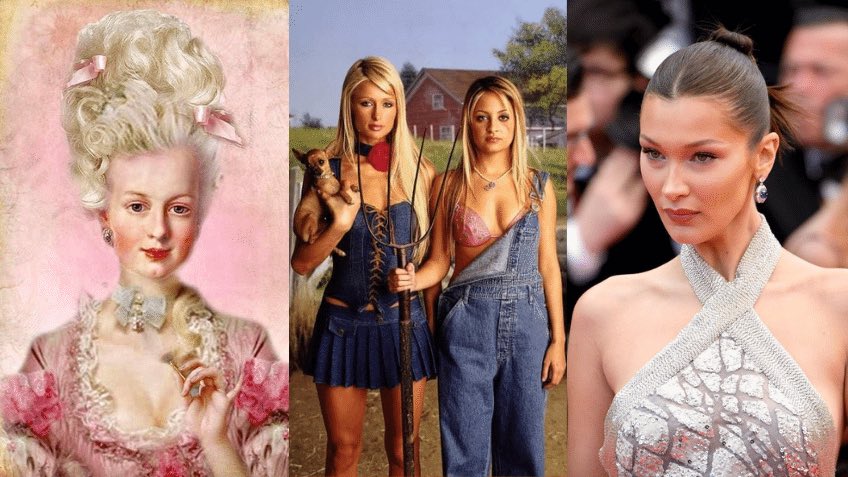The Incredible History Of Hair Styling
by BRENDA L. / NOV 22, 2022

Reading Time: 8 Minutes
Straightening your hair in the morning before going to work might sound like a mundane action nowadays, but did you know that even something as simple as that has an incredible history behind? Curling wands, hair straighteners, wigs, weaves and hair extensions have a much older origin than you might think!
1The Evolution Of Hair Styling
10.000 BC
If you think that colourful wigs and fancy scissors are a thing relatively recent… Well, you’re right. But humans had hair since waaaay before that, and how did they take care of it? Well, anthropologic finds tell us that even in 10.000 BC our kind had to take care of their (musky, for sure) tresses, one way or another. How did that happen? Sharp rocks and shells were a caveman’s tools of choice to get a good trim.
1300 BC
Ancient Egypt has a rich history in beauty and hair care. From elaborated shaved cuts to wigs and braiding techniques, ancient Egyptians knew a great deal of styling methods and used them as cultural and identity expressions. Children had their lock of youth cut off as they hit puberty, whilst men could easily be split between low and high class by whether they were wearing a wig or not. Women in ancient Egypt used flowers, gold strands, beads, ribbons and elaborated jewellery in their tresses depending on their social status; high class women, like men, used to wear curly or plaited hair. For a brief time, short hair became very trendy among the ladies of Egypt!
1500 BC
Henna became a staple in the hair care routine of ancient Egyptians. To this day, henna is widely used as a natural hair dye and a protective treatment for hair. Pretty much everywhere in the world, henna is widely known for its benefits and as a temporary tattoo technique, utilised for ceremonies and weddings in different cultures.
400 BC
Women from ancient Greece started curling their hair with bronze rods. This is one of the oldest examples of a curling wand in history!
300 BC
Ancient Rome and its fancy hairstyles are famous. Wigs, hair colours and hairstyles are still extremely important in determining the status and class of a person: in particular, red dye was considered extremely trendy and seductive amongst women of upper and middle class. Blonde hair was imported from nearby Germany whilst darker shades came all the way from India; for this reason, these two particular types of human hair wigs were particularly pricey. The palla was an elaborated veil draped around the head and falling over the shoulder, used to cover their hair to remark the respectable status of married women. Big and tall hairstyles had a moment, particularly in the Flavian era.
1400s
Let’s jump a little forward in time, to a (today considered bizarre) beauty practice widely diffused amongst upper class women in the Renaissance period. During this time, plucking the frontal part of one’s hairline was quite common, a practice endured to obtain a wider forehead. To think that people nowadays resort to clip-in bangs to cover it… is quite interesting!
1500s
One of the first scalp treatments gets documented. The recipe includes boiled slugs, olive oil, saffron, cumin, soap and honey to restore hair; nowadays the recipes are slug-free - although some ingredients such as olive oil and honey are still renowned for their nourishing properties. If you’re exploring the idea of trying some read our dedicated blog DIY hair mask ideas.
1600s
The word “hairdresser” becomes associated with a professional that takes care of hair, scalp, wearing and styling wigs and much more. The profession is widely spread in Europe, and officially recognised as a specialised job. During the first part of the century, the capital of France, Paris, meets the controversial figure of Champagne, a famous hairdresser known for his rudeness towards the upper class clientele. In the meantime, England sees a rise in fame in bleached blonde shades and red dye, made famous by the hundreds of wigs worn by Queen Elizabeth I. But what about men? Well, as Charles II struggled with his own thinning hair, he revamps the use of wigs on men, making it a trendy accessory worn by upper class gentlemen for over a hundred years!
1700s
Marie Antoinette becomes an icon of big “tower” hairstyles. Did you know her original shade was strawberry blonde? This gorgeous colour is very in nowadays - Sydney Sweeney has recently changed her natural blonde hair to this blushy shade - but Marie Antoinette often chose a pale shade of grey for her elaborated wigs. At some point, the queen’s extravagant hairstyles reached a height of 4 feet, and often included flowers, tulle, ribbons and feathers. When they say “your hair looks like a bird’s nest”...
In the second half of the century, after wig powders started to get heavily taxed, men quickly started dropping their wigs to avoid a financial crisis. Perhaps I should learn a thing or two from them! Also, English hairdressers began to produce the first shampoo! After borrowing the word from the Hindi language, they started preparing the product by boiling soap in water with added fragrances and herbs.
1800s
Metal hot combs and hair straighteners are invented and used to straighten curly hair. As the profession of hairdresser is now officially established and renowned in many parts of the world, Chicago sees the opening of its first hairdressing academy. Towards the end of the century, Alexandre Godefoy invented the first electric hair dryer.
1900s
Hairdressing is now accessible to pretty much any social class. Only five years after the beginning of the century, Charles Nessler invented the permanent wave. This is the founding father of the perm we know nowadays: Nessler’s recipe used borax paste and electrically heated curlers. If you’re worried about the things to consider before getting a perm now, know that back in the days, perms took 12 hours to conduct and cost the client hundreds of dollars. Shocking!
A couple of years later, the founder of L’Oreal created the first synthetic hair dye; in the 1910s Madame C.J. Walker creates a line of products designed for black hair and bobby pins are introduced in America for the first time ever. A decade later, the short bob became the signature hairstyles for the “flapper girl”; a whole century later, this hairstyle is still very trendy.
In the 1950s platinum blonde became extremely popular thanks to diva Marilyn Monroe. This shade is still a best-seller, and our platinum blonde hair extensions are a fan favourite. Sewn-in weaves became a popular form of human hair extensions around the same time.
During the 60s, hair became a big thing - quite literally. Puffs and beehives were extremely popular, and people started using clip-in hair extensions to get the necessary volume and length to create these styles. The big hair trend evolved in the 70s too, where what we now call the “retro blowout” gained fame thanks to Farrah Fawcett. The “Jheri curl” explodes in the black hair scene, as worn by Rick James, Michael Jackson and later on Ice Cube.
In 1980 Theora Stephens invented the first modern-day curling iron, as curls and perms became extremely popular throughout the whole decade. These are the years of puffy curly bangs and colourful touches, and backcombing and funky coloured hair extensions became a staple in the routine of glam rockers.
Finally, the 90s let us explore a plethora of different hairstyles and fashion changes. Poker straight locks became very popular thanks to supermodel Naomi Campbell, although the big bouncy blowout and ponytails were still widely appreciated; hair straighteners became commercially available to the public; Geri Halliwell sported the world’s most famous Money Piece hairstyle of the century.
2000s
The Y2K era had a lot going on in terms of hair care and styling. Mixed shades and chunky highlights became extremely popular, and mixed shade hair extensions followed up. Paris Hilton and Nicole Richie (often named as the queens of this era) are often seen wearing permanent hair extensions to switch up their looks. Following this trend, many women decided that the edgy haircuts of the 90s had to be amended by the use of glued hair extensions, the outdated predecessor of nano ring hair extensions and micro ring hair extensions. Read Our dedicated blog the differences between nano hair extensions and micro loop hair extensions, to find out more!
2010s
Long hair and the deep side part are still a thing, and ombre hair became popular in the alternative fashion scene. Tape-in hair extensions get invented: this is a total revolution in the world of hair makeovers. To this day, tape hair extensions are widely known for their zero-damage approach and fast application. The wefts are fitted to “sandwich” your natural hair in between, and are still an extremely popular option for those who like to wear their hair down. In the mid to late 2010s, the balayage dyeing technique replaced the older highlights methods, and are still a celebrity favourite. Balayage hair extensions rapidly grew in popularity to follow the trend.
2020s
Well, there’s a lot to unpack here! Y2K fashion trends have been heavily revamped and revisited by nostalgic celebrities such as Bella Hadid and Doja Cat. The spiky bun (also known as the model-off-duty bun), the retro ponytail, Money Piece hair, butterfly clips and many more hairstyles rose back from the dead, establishing a throwback fashion movement that borrows clothing pieces and hair trends from decades such as the 60s and 70s, the 90s and the early 2000s. You can read more about Y2K hairstyles and how to achieve them on our dedicated blog. In 2022, red hair finds renewed popularity (Roman ladies would be so proud!) and hairdressers and stylists started stocking up their shelves with boxes of copper shades. Cliphair expanded their roster of red hair extensions.
2Conclusion:
The history of hair care and styling is incredibly detailed and rich of creative ideas; as we know, history likes to repeat itself sometimes and it’s not unusual to see hair trends come back and fade out shortly after, just to get revamped a few decades (perhaps even centuries?) later by influential figures and celebrities.
Looking for flawless, salon-worthy hair without breaking the bank? At Cliphair, we’ve got you covered with luxurious clip in hair extensions for quick transformations and permanent hair extensions for long-lasting glam. Extensions require special care and maintenance to preserve their quality, which is why we have all the top-notch hydrating haircare products needed to keep your style on point.
Need the perfect shade? Browse our full range of human hair extensions in over 70 rich, silky shades or check out our FREE Express Color Match Service to ensure a seamless blend every time.







